
The 26 cantons of Switzerland are the member states of the Swiss Confederation. The nucleus of the Swiss Confederacy in the form of the first three confederate allies used to be referred to as the Waldstätte. Two important periods in the development of the Old Swiss Confederacy are summarized by the terms Acht Orte and Dreizehn Orte.
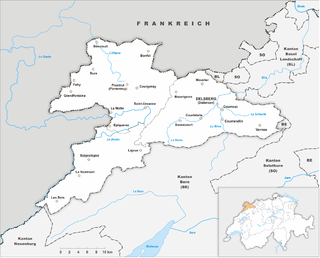
The Republic and Canton of Jura, less formally the Canton of Jura or Canton Jura, is the newest of the 26 Swiss cantons, located in the northwestern part of Switzerland. The capital is Delémont. It shares borders with the canton of Basel-Landschaft, the canton of Bern, the canton of Neuchatel, the canton of Solothurn, and the French régions of Bourgogne-Franche-Comté and Grand Est.
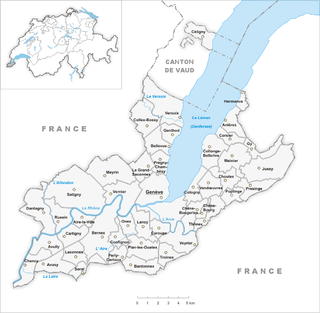
The Canton of Geneva, officially the Republic and Canton of Geneva, is one of the 26 cantons of the Swiss Confederation. It is composed of forty-five municipalities, and the seat of the government and parliament is in the City of Geneva.

Delémont is the capital of the Swiss canton of Jura. The city has approximately 12,000 inhabitants as of 2013.
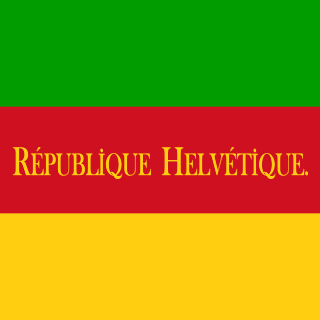
The Helvetic Republic was a sister republic of France that existed between 1798 and 1803, during the French Revolutionary Wars. It was created following the French invasion and the consequent dissolution of the Old Swiss Confederacy, marking the end of the ancien régime in Switzerland. Throughout its existence, the republic incorporated most of the territory of modern Switzerland, excluding the cantons of Geneva and Neuchâtel and the old Prince-Bishopric of Basel.
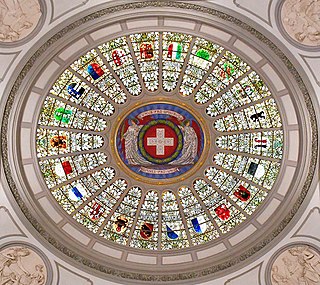
Each of the 26 modern cantons of Switzerland has an official flag and a coat of arms. The history of development of these designs spans the 13th to the 20th centuries.
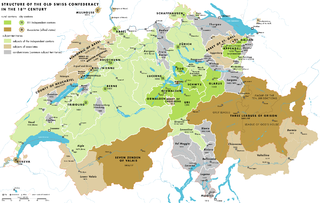
The early modern history of the Old Swiss Confederacy and its constituent Thirteen Cantons encompasses the time of the Thirty Years' War (1618–1648) until the French invasion of 1798.

During the French Revolutionary Wars, the revolutionary armies marched eastward, enveloping Switzerland in their battles against Austria. In 1798, Switzerland was completely overrun by the French and was renamed the Helvetic Republic. The Helvetic Republic encountered severe economic and political problems. In 1798 the country became a battlefield of the Revolutionary Wars, culminating in the Battles of Zürich in 1799.

Porrentruy is a Swiss municipality and seat of the district of the same name located in the canton of Jura.

A sister republic was a republic established by French armies or by local revolutionaries and assisted by the First French Republic during the French Revolutionary Wars. These republics, though nominally independent, relied heavily on France for protection, making them more akin to autonomous territories rather than independent states. This became particularly evident after the declaration of the French Empire, when several states were annexed, and the remaining turned into monarchies ruled by members of the Bonaparte family.

Basel was a canton of Switzerland that was in existence between 1501 and 1833, when it was split into the two half-cantons of Basel-City and Basel-Country.

The Old Swiss Confederacy, also known as Switzerland, or the Swiss Confederacy was a loose confederation of independent small states, initially within the Holy Roman Empire. It is the precursor of the modern state of Switzerland.

The Prince-Bishopric of Basel was an ecclesiastical principality within the Holy Roman Empire, ruled from 1032 by prince-bishops with their seat at Basel, and from 1528 until 1792 at Porrentruy, and thereafter at Schliengen. As an imperial estate, the prince-bishop had a seat and voting rights at the Imperial Diet. The final dissolution of the state occurred in 1803 as part of the German Mediatisation.

Mont-Terrible was a department of the First French Republic, with its seat at Porrentruy.

The French invasion of Switzerland occurred from January to May 1798 as part of the French Revolutionary Wars. The independent Old Swiss Confederacy collapsed from the invasion and simultaneous internal revolts called the "Helvetic Revolution". The Swiss ancien régime institutions were abolished and replaced by the centralised Helvetic Republic, one of the sister republics of the French First Republic.

Moutier-Grandval Abbey was a Benedictine abbey near the villages of Moutier and Grandval in today's Bernese Jura, Canton of Bern in Switzerland. It was founded around 640, when Grandval already existed; Moutier grew up around the abbey.

Sauge is a municipality in the Jura bernois administrative district in the canton of Bern in Switzerland. It is located in the French-speaking Bernese Jura. On 1 January 2014 the former municipalities of Plagne and Vauffelin merged into the municipality of Sauge.

Valbirse is a municipality in the Jura bernois administrative district in the canton of Bern in Switzerland. It is located in the French-speaking Bernese Jura.
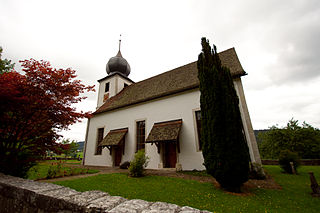
Petit-Val is a municipality in the Jura bernois administrative district in the canton of Bern in Switzerland. It is located in the French-speaking Bernese Jura. On 1 January 2015 the former municipalities of Châtelat, Monible, Sornetan and Souboz merged to form the new municipality of Petit-Val.
A referendum on annexation by the French First Republic was held in the Rauracian Republic, a sister republic of France, between 4 and 7 March 1793. Of the 115 deputies meant to represent the voting results of their communities, only 41 reliable ones were admitted, who on the 7th confirmed the annexation to France as decided by the first two assemblies.




















